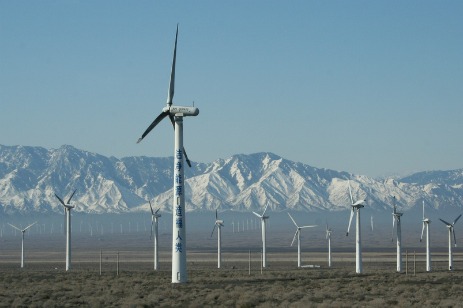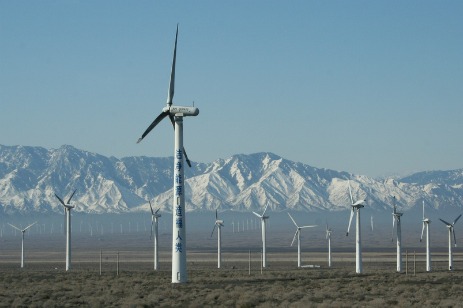 Wind turbines in western China.Photo: Kaj IversonInstallation of new wind power capacity in the United States is expected to decline 39 percent this year, according to a report [PDF] released Thursday.
Wind turbines in western China.Photo: Kaj IversonInstallation of new wind power capacity in the United States is expected to decline 39 percent this year, according to a report [PDF] released Thursday.
Now that would be a brutal blow for any industry battered by a vicious recession. But it’s particularly bad news for the American wind industry, which had defied the downturn by installing a record 10,000 megawatts of new capacity in 2009. New wind capacity had grown an average 39 percent annually over the previous five years and represented 39 percent of all new electrical generation that came online last year.
China, meanwhile, has become the world wind leader and is projected to install 14,000 megawatts of new capacity this year, a 25 percent spike from 2009, according to Bloomberg New Energy Finance, a renewable power research and consulting firm.
“Approximately one in two wind turbines to go online in 2010 will be in China,” the Bloomberg report states. “The U.S. market continues to be challenged by fallout from the financial crisis, low power prices and an uncertain medium-to-long term policy environment.”
In other words, the inability of the United States to enact federal climate change legislation or a national renewable energy standard and its Lucy-Charlie-Brown-and-the-football approach to financial incentives for wind power — no, really I won’t yank those tax breaks away this time, come on kick the ball — has made investing in multibillion-dollar wind projects a gamble.
China, on the other hand, has poured billions into its domestic wind industry with the avowed goal of becoming a global leader in the industry. It’s largely because of Chinese demand that new worldwide capacity only declined an estimated 2 percent in 2010.
“The emergence of China as the world’s leading wind market in the last two years is driving a fundamental rebalancing of industrial focus,” William Young, Bloomberg New Energy Finance’s chief of wind industry research, said in a statement. “Chinese turbine manufacturers have muscled their way onto the top table.”
So is the U.S. just tilting at turbines?
In the U.S., plummeting natural gas prices may be just as a big a culprit as a dysfunctional political system. When natural gas-fired electricity is dirt cheap, utilities think twice about signing contracts to buy much more expensive wind power — especially if they’re located in a state without a strong mandate to purchase renewable energy.
On Wednesday, I happened to be talking to Stuart Hemphill, senior vice president of power procurement at utility Southern California Edison, about the impact of low natural gas prices on the competitiveness of renewable energy projects.
Hemphill noted that over the past couple of years, natural gas prices have plunged from $14 per million BTU to $2 per million BTU.
“Natural gas as fuel has become extraordinarily competitive,” he said, noting that the boom in shale gas production is contributing to the downward pressure on prices.
There was some good news in the Bloomberg New Energy Finance report: The industry should bounce back in 2011. The question, of course, is just where that bounce back will happen.



